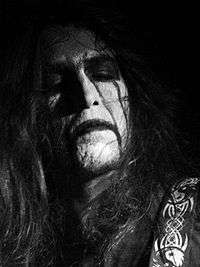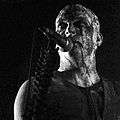Corpse paint

Corpse paint or corpsepaint is a style of black and white makeup used by black metal bands for concerts and band photos. The makeup is used to make the musicians appear inhuman, corpse-like, or demonic, and is perhaps "the most identifiable aspect of the black metal aesthetic."[2]
Corpse paint typically involves making the face and neck white and making the area around the eyes and lips black. Musicians will often have a trademark style. Other colors are seldom used, yet there are notable exceptions, such as Attila Csihar's use of neon colors and the bands Satyricon and Dødheimsgard experimenting with color as well.
Outside of black metal, face-painting has been used by a variety of other public figures such as shock rock artists (notably Arthur Brown, Alice Cooper, KISS, and members of the Misfits) and professional wrestlers (e.g. Sting and Vampiro).
History and usage

The earliest rock groups to wear makeup similar to corpse paint included Screamin' Jay Hawkins and Arthur Brown in the 1960s; Secos & Molhados, Alice Cooper and KISS in the 1970s; and later that decade, punk rock bands like the Misfits and singer David Vanian of The Damned. On seeing shock rock pioneer Arthur Brown performing his US number two hit "Fire" in 1968, Alice Cooper states, "Can you imagine the young Alice Cooper watching that with all his make-up and hellish performance? It was like all my Halloweens came at once!."[3]
In the 1980s, Hellhammer and King Diamond of Mercyful Fate (who used corpse paint as early as 1978 in his band Black Rose) were among the early metal groups to use corpse paint. Per "Dead" Ohlin was the first to explicitly associate stylized face paint with an attempt to look like a corpse according to Mayhem drummer Jan Axel "Hellhammer" Blomberg.[4] Other groups soon followed suit, including Hellhammer's later incarnation Celtic Frost. Brazilian band Sarcófago also pioneered the look, being dubbed by Metal Storm magazine as the first band with "true" corpse paint.[5] However, Necrobutcher insists that his band Mayhem was the first to use corpse paint and credits the band's singer Per "Dead" Ohlin with coining the term.[6] Early corpse paint was meant simply to highlight an individual's features and make them look "dead."
Bands of the early Norwegian black metal scene used corpse paint extensively. Early vocalist of Mayhem Per "Dead" Ohlin started wearing it in the late 1980s. According to Necrobutcher, Mayhem's bass player: "It wasn't anything to do with the way Kiss and Alice Cooper used make-up. Dead actually wanted to look like a corpse. He didn't do it to look cool."[7] In the early 1990s, other Norwegian black metal bands followed suit and their style and sound was adopted by bands around the world. Eventually, some Norwegian bands—such as Emperor and Satyricon—stopped wearing corpse paint, often citing its loss of meaning or trendiness due to use by so many bands.
Examples



 Taalroth of Hindvir
Taalroth of Hindvir Otargos
Otargos
 Hoest of Taake
Hoest of Taake
 Attila Csihar performing with Mayhem
Attila Csihar performing with Mayhem
See also
References
- ↑ Miles, Barry (2009). The British Invasion: Arthur Brown. Sterling Publishing Company, Inc.,. p. 274.
- ↑ Patterson, Dayal: Black Metal: Evolution of the Cult; 2013, Feral House, Port Townsend, Washington; p. 144.
- ↑ "Alice Cooper Recruits Arthur Brown For Fire-themed Halloween Show". Ultimate Classic Rock. December 29, 2017.
- ↑ Interview with Hellhammer conducted by Dmitry Basik June 1998
- ↑ On the Role of Clothing Styles In The Development of Metal - Part I - Metal Storm
- ↑ Patterson, Dayal: Black Metal: Evolution of the Cult; 2013, Feral House, Port Townsend, Washington; p. 144.
- ↑ Chris Campion: In the Face of Death. In: The Observer, 20. February 2005.
External links
- Rate My Corpse Paint Examples of different styles of corpse paint.
- How To Apply Corpse Paint
- Dravenstales.ch Brief history of corpse paint